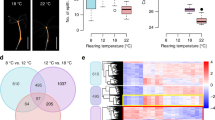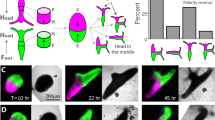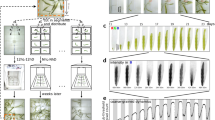Abstract
TRIPP1 proposed a growth pattern for Hydra which was later confirmed by Brien2 and Burnett and Garofalo3. Beneath the hypostome of Hydra a growth region exists where cell proliferations constantly occur. Cell divisions in this area force adjacent cells distally to the tentacle tips and proximally to the basal disk. When cells reach the extremity of the body column they die and are sloughed off. Thus, the animal is capable of continual growth without a change in form.
This is a preview of subscription content, access via your institution
Access options
Subscribe to this journal
Receive 51 print issues and online access
$199.00 per year
only $3.90 per issue
Buy this article
- Purchase on Springer Link
- Instant access to full article PDF
Prices may be subject to local taxes which are calculated during checkout
Similar content being viewed by others
References
Tripp, K., Z. Wise. Zool., 132, 476 (1928).
Brien, P., and Reniers-Decoen, M., Bull. Biol. France and Belg., 82, 293 (1949).
Burnett, A., and Garofalo, M., Science, 131, 160 (1960).
Burnett, A., J. Exp. Zool., 146, 21 (1961).
Diehl, F., and Burnett, A., J. Exp. Zool., 155, 253 (1964).
Author information
Authors and Affiliations
Rights and permissions
About this article
Cite this article
LESH, G., BURNETT, A. Some Biological and Biochemical Properties of the Polarizing Factor in Hydra. Nature 204, 492–493 (1964). https://doi.org/10.1038/204492b0
Issue Date:
DOI: https://doi.org/10.1038/204492b0
This article is cited by
-
Bud formation inHydra: Inhibition by an endogenous morphogen
Wilhelm Roux's Archives of Developmental Biology (1977)
-
Induction of Growth in Newt and Frog Limbs after Perfusion with Extracts from Newt Blastemas
Nature (1971)
-
Bedeutung der kolonialen Komponenten f�r die Bildung und Differenzierung der Medusen vonPodocoryne carnea M. Sars
Wilhelm Roux' Archiv f�r Entwicklungsmechanik der Organismen (1971)
-
Further observations on dividing and non-dividing cnidoblasts in the regenerating isolated gastrodermis of Hydra
Zeitschrift f�r Zellforschung und Mikroskopische Anatomie (1970)
-
Cellular differentiation and morphogenesis in Cordylophora
Wilhelm Roux' Archiv f�r Entwicklungsmechanik der Organismen (1969)
Comments
By submitting a comment you agree to abide by our Terms and Community Guidelines. If you find something abusive or that does not comply with our terms or guidelines please flag it as inappropriate.



